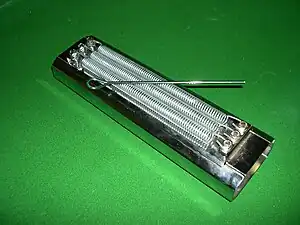

The reco-reco (also called the raspador, caracaxá or querequexé) is a scraper of African origin used as a percussion instrument in Brazilian music,[1] but also in many Latin American countries, where it is known as güiro, güira, guayo and guacharaca.
Traditionally, the reco-reco was made from a sawtooth notched cylindrical body made of bamboo or wood, and played with a wooden stick. The instrument is used in many styles of Brazilian music, such as samba and related genres.
For some time, reco-recos have been made of a metallic cylinder with springs attached and played with a metal stick, which results in a much louder sound. In some models, the sound box has a hole on the bottom part, which can be covered with the hand to achieve different timbral possibilities. Nowadays, reco-recos have also been made out of fiberglass, but the wooden version remains the most popular.
See also
Notes
- ↑ ROCCA, Edgar Nunes "Bituca", Escola Brasileira de Música: Uma visão Brasileira no ensino da música e seus instrumentos de percussão 1. Rio de Janeiro: Europa, EBM, 1986
References